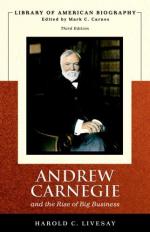
|
| Name: _________________________ | Period: ___________________ |
This test consists of 5 multiple choice questions, 5 short answer questions, and 10 short essay questions.
Multiple Choice Questions
1. From 1867 through 1872, Andrew Carnegie joins the expansion trend by manipulating what stock to promote $30 million in stocks and bonds in Europe?
(a) Woodruff and Western Union.
(b) Western Union and Union Pacific.
(c) Pennsylvania Railroad and Western Union.
(d) Union Pacific and Pennsylvania Railroad.
2. Scott and Thomson hold stock in Carnegie's name for what reason?
(a) They are afraid to hold stock in their own.
(b) To avoid impropriety for Carnegie's one-eighth interest.
(c) Carnegie will not allow them to hold stock in anyone else's name.
(d) Carnegie is very well-known and trusted.
3. Railroads link Pittsburgh to the Atlantic coast and eventually to the Pacific coast, with the _______________ the best of them all.
(a) Union Pacific.
(b) Pennsylvania Railroad.
(c) BNSF Railway Company.
(d) CSX Corporation.
4. What railroad focuses capital investments that either increase revenue or reduce unit cost to justify them?
(a) Pennsylvania.
(b) Union Pacific.
(c) CSX.
(d) BNSF.
5. Thirteen year-old Andrew sees his father fail while admiring whose determination to rise above it?
(a) His mother's.
(b) His uncle's.
(c) His brother's.
(d) His aunt's.
Short Answer Questions
1. With whom does Carnegie form Columbia Oil Company?
2. Andrew's opportunity to escape the coal and oil of textile mills comes through _________ asking him to become a messenger boy with a telegraph company in Pittsburgh.
3. Whose pioneering skills in management are codified in his "Book of Rules and the Employees' Timetable?"
4. Who is the cornerstone of Carnegie's fortune, followed in 1861 by Columbia Oil?
5. Carnegie uses $11,000 in Woodruff dividends to buy 1,100 shares that pay $17,800 in their first year and eventually over _________ dollars.
Short Essay Questions
1. What does Carnegie learn at the Pennsylvania Railroad?
2. How is Pittsburgh important at this time?
3. What characterizes America? To what does this refer?
4. What does Carnegie do in Europe?
5. Describe the Pennsylvania Railroad in 1865.
6. By what is this dream not diminished?
7. Describe Carnegie's rise in business by 1865.
8. Give an example of when Carnegie meets railroad's customers and initiates control of division operations when needed.
9. Describe the informal investing triumvirate Carnegie formed with Thomson and Scott.
10. Describe Carnegie's investment in Keystone Bridge Company.
|
This section contains 952 words (approx. 4 pages at 300 words per page) |

|




